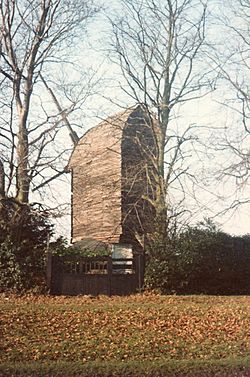Keston Windmill facts for kids
Quick facts for kids Keston Windmill |
|
|---|---|

Keston mill, 4 February 1982
|
|
| Origin | |
| Grid reference | TQ 415 640 |
| Coordinates | 51°21′25″N 0°01′59″E / 51.357°N 0.033°E |
| Operator(s) | Privately owned |
| Year built | 1716 |
| Information | |
| Purpose | Corn milling |
| Type | Post mill |
| Storeys | Three storeys |
| Roundhouse storeys | Single storey |
| No. of sails | Four |
| Type of sails | Double Patent sails |
| Windshaft | cast iron |
| Winding | Tailpole |
| No. of pairs of millstones | Two pairs located in the breast |
Keston Windmill is a very old and special windmill. It is located in Keston, which is now part of the London Borough of Bromley. This windmill was built a long time ago, in 1716. It is a 'Grade I listed building', which means it's a very important historical site. The mill is kept safe with all its original parts still inside, but it does not work anymore.
History of Keston Windmill
Keston Windmill was built in 1716. A mill builder named William Ashby fixed new sails and other parts in December 1836. The windmill continued to grind corn using wind power until either 1878 or 1900. In 1955, the local council made sure the mill would be protected. The main job of the mill was to grind corn into flour. Today, the mill is owned by a private person. It is kept in good condition with all its machinery, but it is not usually open for people to visit.
How Keston Mill Works
Keston Mill has a main body that is three stories tall. This body sits on a round building that is one story high. The round building covers the main support structure of the mill, called the trestle. The year 1716 is carved into the main post of the mill.
The mill had four large sails, called double Patent sails. These sails were attached to a strong windshaft made of cast iron. To turn the mill into the wind, a long pole called a tailpole was used. Inside, a large wooden wheel, the brake wheel, turned a cast-iron gear called a wallower. This then turned another large gear, the great spur wheel, which had wooden teeth. This system powered two pairs of millstones at the front of the mill. These stones ground the corn. The mill also had a flour dresser, which was a machine to separate the flour from the bran. A similar flour dresser was later built for another windmill using Keston's as a guide.
Millers of Keston
Here are some of the people who worked as millers at Keston Windmill:
- John Ellis (in 1838)
- Thomas Ellis (in 1845)
- Martin J Hoath (in 1845)
- B Hoadley (in 1862)

